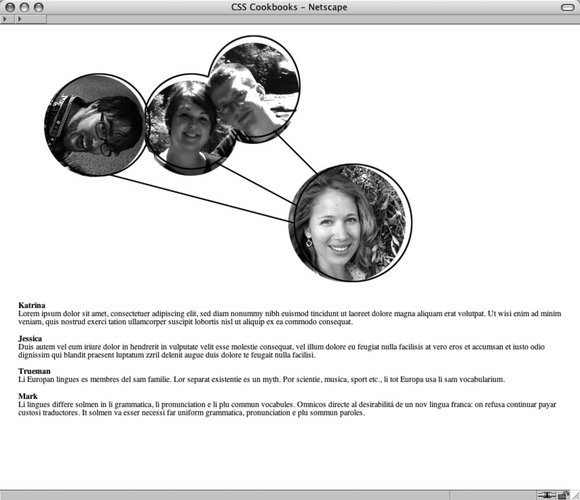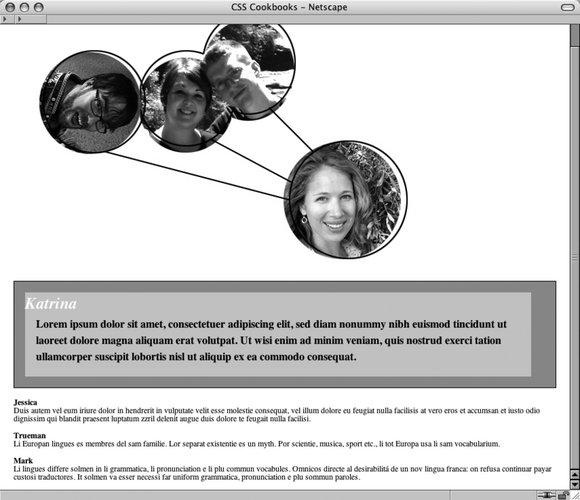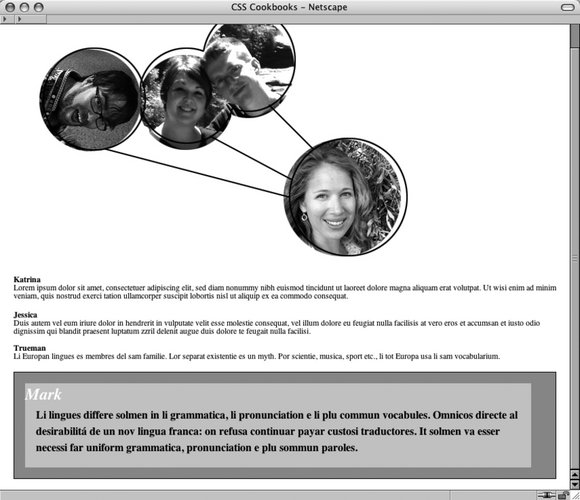Recipe 6.16. Apply Styles Dynamically to a Web Page
ProblemYou want to change the style of elements within a web page when a user clicks on a link. SolutionFirst, set up the markup with normal anchored links within the document. For this solution, the anchored links (technically referred to as fragment identifiers) are placed within an image map: <img src="/books/3/27/1/html/2/target_header.jpg" alt="Header" border="0" usemap="#Map" /> <map name="Map" > <area shape="circle" coords="115,136,72" href="#mark" /> <area shape="circle" coords="244,145,55" href="#jessica" /> <area shape="circle" coords="340,88,58" href="#trueman" /> <area shape="circle" coords="480,287,79" href="#katrina" /> </map> <div > <dl > <dt>Katrina</dt> <dd>...</dd> </dl> <dl > <dt>Jessica</dt> <dd>...</dd> </dl> <dl > <dt>Trueman</dt> <dd>...</dd> <dl > <dt>Mark</dt> <dd>...</dd> </div> Then set up CSS rules for the default styles for the web page (see Figure 6-30): .bios dt { font-weight: bold; } .bios dd { margin: 0; padding: 0; } Figure 6-30. The default rendering of the web page Then use the target pseudo-class to define the look of the elements when the user clicks on the anchored link (see Figure 6-31): .bios dl:target { background-color: #999999; border: 1px solid black; padding: 1em; font-weight: bold; line-height: 1.5; } .bios dl:target dt { font-style: italic; color: white; font-size: 1.5em; background-color: #cccccc; margin-right: 20px; } .bios dl:target dd { margin-right: 20px; background-color: #cccccc; padding: 0 1em 1em 1em; } Figure 6-31. The Katrina portion of the page changed style To return the targeted element(s) back to their default style when the user clicks on another anchored link, use the negation pseudo-class (see Figure 6-32): .bios dl:not(:target) { border: none; padding: 0; font-size: .8em; } Figure 6-32. The Katrina portion reverted back to its default value when another link was activated DiscussionThe : target and :not pseudo-classes are a part of the CSS 3 specification and thus aren't well-known to most web designers. However, the selectors can perform a great deal of heavy lifting. Pure CSS collapsible menusBy working with these selectors, the JavaScript-based solution in Recipe 6.12 can be replaced with a few extra CSS rules. First, update the markup to add the anchor link: <h5> <a href="#menulink">Interesting Links</a> </h5> <ul > <li><a href="http://www.ora.com/">O'Reilly</a></li> <li><a href="http://www.slashdot.org/">Slashdot</a></li> <li><a href="http://www.apple.com/">Apple</a></li> <li><a href="http://www.microsoft.com/">Microsoft</a></li> <li><a href="http://www.mozilla.org/">Mozilla</a></li> </ul> Then set up the following CSS rules: /* default rendering */ ul#menulink { display: none; } /* when 'targeted' */ ul:target { display: block; } /* revert back to default rendering */ ul:not(:target) { display: none; }Currently collapsible menus and :target pseudo-classes are supported in Firefox, Mozilla, Safari, and Internet Explorer 7 for Windows. See AlsoThe CSS 3 specification for the :target pseudoclass at http://www.w3.org/TR/css3-selectors/#target-pseudo. |
EAN: 2147483647
Pages: 235